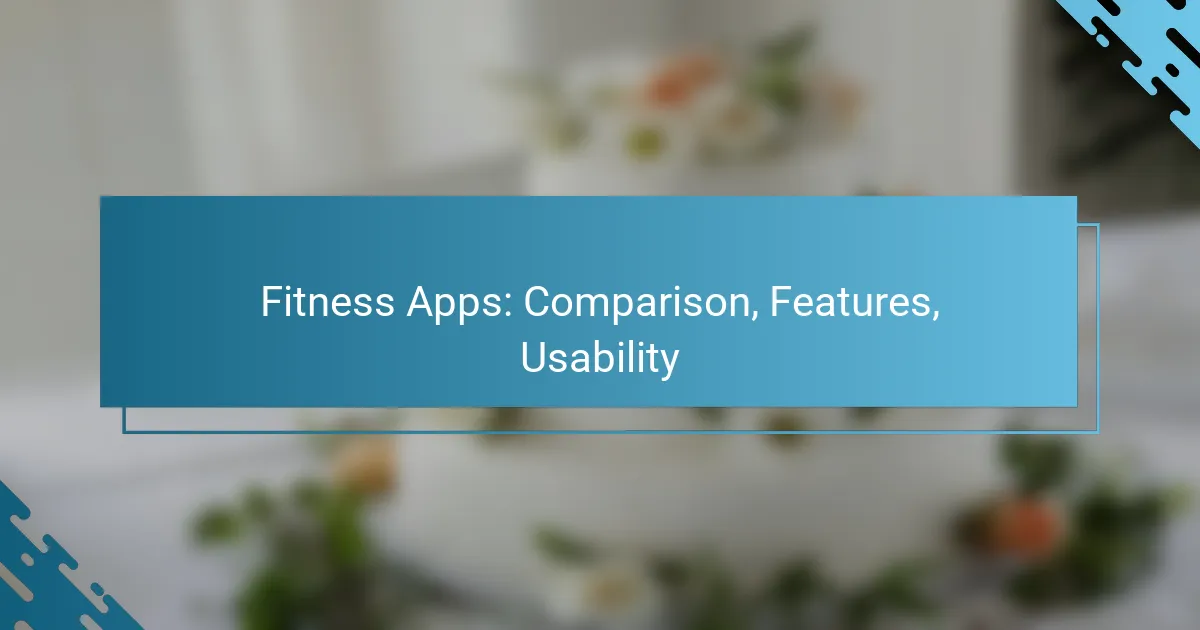As fitness technology continues to evolve, the best fitness apps of 2023 provide diverse features to help users monitor workouts, nutrition, and overall health. With options like MyFitnessPal, Fitbit, and Strava, each app caters to unique preferences and fitness goals. Understanding the differences in tracking capabilities, usability, and community engagement is essential for selecting the right app to enhance your fitness journey.

What Are the Best Fitness Apps for 2023?
The best fitness apps for 2023 offer a range of features to help users track their workouts, monitor nutrition, and achieve their fitness goals. Popular options include MyFitnessPal, Fitbit, Strava, Apple Fitness+, and Google Fit, each catering to different needs and preferences.
MyFitnessPal
MyFitnessPal is a comprehensive app primarily focused on nutrition tracking. Users can log their meals and exercise, making it easier to maintain a balanced diet and monitor calorie intake. The app boasts a vast database of foods and allows for barcode scanning, simplifying the logging process.
Consider using MyFitnessPal if you want to lose weight or manage your diet effectively. Its social features enable users to connect with friends for motivation, but be aware that some advanced features require a premium subscription.
Fitbit
Fitbit is designed to work seamlessly with Fitbit devices, tracking various health metrics such as steps, heart rate, and sleep patterns. The app provides personalized insights based on your activity levels, helping you set and achieve fitness goals.
If you own a Fitbit device, this app is a natural choice. It encourages daily activity and offers challenges to keep users engaged. However, without a Fitbit device, the app’s capabilities are limited compared to other options.
Strava
Strava is ideal for runners and cyclists, offering detailed tracking of workouts and routes. Users can analyze their performance over time and compare their results with others in the community. The app also features social elements, such as sharing achievements and participating in challenges.
Choose Strava if you enjoy outdoor activities and want to connect with a community of athletes. However, some features, like advanced analytics, are only available with a subscription.
Apple Fitness+
Apple Fitness+ integrates with Apple Watch to provide personalized workout recommendations based on your fitness level and preferences. The app offers a variety of classes, including yoga, strength training, and HIIT, led by professional trainers.
This app is best for Apple device users looking for a comprehensive fitness solution. It requires a subscription, but the integration with other Apple services enhances the overall experience. Make sure to have an Apple Watch for optimal functionality.
Google Fit
Google Fit is a versatile fitness app that tracks activity and health metrics using your smartphone or Wear OS devices. It focuses on heart points and move minutes, encouraging users to stay active throughout the day.
Use Google Fit if you prefer a free, straightforward app that integrates well with other Google services. While it lacks some advanced features of competitors, it provides a solid foundation for tracking fitness without any cost.

How Do Fitness Apps Compare in Features?
Fitness apps vary significantly in features, impacting their usability and effectiveness. Key areas of comparison include tracking capabilities, workout plans, nutrition guidance, and community engagement, each influencing user experience and fitness outcomes.
Tracking Capabilities
Tracking capabilities are essential for monitoring progress and staying motivated. Most fitness apps offer features such as step counting, distance tracking, and calorie monitoring. Some advanced apps even integrate heart rate monitoring and sleep tracking, providing a comprehensive view of health metrics.
When choosing an app, consider what you want to track. If you’re focused on weight loss, look for apps that provide detailed calorie tracking and integration with food databases. For runners, GPS tracking and pace analysis may be more critical.
Workout Plans
Workout plans in fitness apps can range from basic routines to personalized training programs. Many apps offer pre-designed workouts targeting specific goals, such as strength building or endurance training. Others allow users to customize their plans based on fitness levels and preferences.
Look for apps that provide variety in workouts to prevent boredom and promote consistent engagement. Some apps may also include video demonstrations, which can be helpful for ensuring proper form and technique.
Nutrition Guidance
Nutrition guidance is a vital feature for those looking to improve their diet alongside fitness. Many fitness apps provide meal planning tools, calorie counters, and nutritional information for various foods. Some even offer recipes tailored to specific dietary needs.
When selecting an app, consider whether it aligns with your dietary preferences, such as vegetarian or low-carb options. Apps that allow you to scan barcodes for quick food logging can save time and enhance accuracy.
Community Engagement
Community engagement features can enhance motivation and accountability. Many fitness apps include social components, such as forums, challenges, and the ability to connect with friends. This interaction can foster a sense of belonging and support.
Choose an app that encourages community participation if you thrive on social interaction. Look for features like leaderboards or group challenges that can help you stay motivated and committed to your fitness journey.

What Are the Usability Factors of Fitness Apps?
Usability factors of fitness apps include user interface design, accessibility features, and integration with devices. These elements significantly impact how effectively users can navigate the app, access its features, and track their fitness goals.
User Interface Design
User interface design is crucial for ensuring that users can easily navigate a fitness app. A clean, intuitive layout with clear icons and straightforward navigation helps users find what they need quickly. Apps that prioritize user experience often use color coding and consistent design elements to guide users through their fitness journey.
Consider apps that offer customizable dashboards, allowing users to prioritize the information they find most relevant, such as workout summaries or progress charts. A well-designed interface also minimizes the number of taps required to access key features, enhancing overall usability.
Accessibility Features
Accessibility features in fitness apps ensure that all users, including those with disabilities, can effectively use the app. This may include voice commands, text-to-speech options, and adjustable font sizes. Apps that comply with accessibility standards, such as the Web Content Accessibility Guidelines (WCAG), are more inclusive.
When choosing a fitness app, look for features like high-contrast modes for better visibility and options for screen reader compatibility. These enhancements not only benefit users with disabilities but also improve usability for everyone by providing more ways to interact with the app.
Integration with Devices
Integration with devices, such as smartwatches and fitness trackers, is a key usability factor for fitness apps. Seamless syncing allows users to track their workouts, heart rate, and other metrics in real-time, providing a comprehensive view of their fitness progress. Popular fitness apps often support multiple devices, enhancing their versatility.
When selecting a fitness app, check its compatibility with your existing devices. Look for apps that can connect to a variety of wearables and health platforms, ensuring that you can consolidate your data and streamline your fitness tracking experience. This integration can significantly enhance motivation and accountability in achieving fitness goals.

How to Choose the Right Fitness App?
Choosing the right fitness app involves understanding your personal fitness goals, budget, and the experiences of other users. By evaluating these factors, you can select an app that aligns with your needs and preferences.
Assess Your Fitness Goals
Begin by identifying your specific fitness objectives, such as weight loss, muscle gain, or improving endurance. Different apps cater to various goals; for instance, some focus on strength training while others emphasize cardio or flexibility.
Consider whether you prefer guided workouts, tracking your progress, or accessing a community for motivation. This clarity will help you narrow down your options to apps that best support your fitness journey.
Consider Budget and Pricing
Fitness apps typically range from free to subscription-based models, with monthly fees varying widely. Free apps may offer basic features, while premium options often include personalized plans, advanced tracking, and additional resources.
Evaluate what you are willing to spend and whether the app’s features justify the cost. Many apps provide trial periods, allowing you to test their offerings before committing financially.
Evaluate User Reviews
User reviews can provide valuable insights into an app’s usability, effectiveness, and customer support. Look for feedback on app performance, ease of navigation, and the quality of workout programs.
Check reviews on multiple platforms to get a balanced view. Pay attention to comments about updates or changes that may affect the app’s functionality over time, ensuring it remains a reliable tool for your fitness goals.

What Are the Pricing Models for Fitness Apps?
Fitness apps typically utilize a variety of pricing models, including free, premium, and subscription-based options. Understanding these models can help users choose the best app for their fitness needs and budget.
Free vs. Premium Options
Many fitness apps offer free versions that provide basic features, allowing users to track workouts, monitor progress, and access limited content. However, premium options often unlock advanced features such as personalized training plans, nutritional guidance, and ad-free experiences.
When considering whether to opt for a free or premium version, users should evaluate their fitness goals. If they require more comprehensive support or specialized features, investing in a premium subscription may be worthwhile.
Subscription Costs
Subscription costs for fitness apps can vary significantly, typically ranging from around $5 to $20 per month, depending on the app’s features and brand reputation. Some apps also offer annual subscriptions that can reduce the monthly cost, often providing a discount for long-term commitments.
Users should assess the value of the features offered in relation to the subscription fee. It’s advisable to take advantage of free trials when available, as this allows users to explore the app’s functionality before committing financially.
